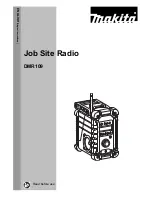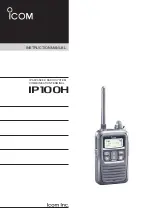
by clicking the
MENU
switch.
Note: DFE mode is not available if RIT is on.
Storing a message:
Click and release the
MENU
switch 4 times to enter the Message store mode. The display will show [ --. ] and the
letter “M” will be annunciated by the side tone. The receiver is then muted and you can now start to enter your
message by using the paddle. If you accidentally activate this mode and do not wish to enter a message, click the
MENU switch to abort before touching the paddle. The Letter “X” will be annunciated and the rig will go back to
normal operation.
Up to 63 characters (including word spaces) may be entered. If you exceed this limit, the letters “EM” will be
annunciated by the side tone and you will have to start again.
Note that “ideal” letter and word timing is used to determine letter element groups and word groups. Of these
two, the letter timing is most critical. If do not pause long enough before starting a new letter, a letter space
will not be detected. If you pause too long, it will be interpreted as a word space. It may take some
practice to
enter a message correctly. To ensure a word space is inserted, it is best to pause somewhat longer than you
normally would between word letter groups. Many people run their letters and words together by not leaving enough
space between letter element groups. If your message come out gibberish, you have that problem.
When you have finished entering the message, click the MENU switch. The message you have entered will be
annunciated by the side tone so you can check the accuracy of the message. If it sounds good, store it by closing
either the DOT or DASH paddle. DASH will store it into message location 1 and DOT into location 2. If you wish to
redo the message, click the MENU switch again. “EM” will be annunciated by the side tone and you can now re-enter
the message.
Sending a message:
To transmit one of the two messages, click and hold close the MENU switch, then tap the dash paddle to send
message 1, or the Dot paddle to send message 2, then release the MENU switch.
If a message has not yet been stored, releasing the
MENU
switch will activate the change code speed mode.
Once started, a message can be terminated by closing the DOT or DASH paddle. The paddles are tested in between
the transmission of characters, so hold the paddle closed long enough to be sensed.
Straight key mode:
If a monaural plug is in the paddle jack at power up (the sleeve grounds the dash input pin), the rig will power
up in straight key mode. This allows using either a straight key or external keyer. While in straight key mode,
none of the keyer switch functions will be available. If a message has been previously stored in the keyer
memories, only memory location 1 will be available, (tap the straight key closed with in 1 second of clicking the
keyer switch) as this is selected with the dot input pin, now controlled by the straight key.
Using the SWR bridge and BLT tuner:
TUNE / OPER SWITCH:
Sliding TUNE / OPER witch to the TUNE position switches in the SWR bridge. The LED will now indicate the relative
amount of SWR. The brighter the LED, the higher the SWR is. When the LED is not lit or is very dim indicates 1:1
SWR.
COAX / BLT SWITCH
The COAX / BLT switch is used to switch between a direct coax connection to the BNC jack or the BLT (balanced
line tuner). The Coax position is of course used if you are using a resonate, coax feed antenna or an external
tuner. The BLT position is used when the built in tuner is desired and is normally used with ladder line feed
antennas, but can also be used for end feed antennas or possibly matching coax feed antennas which need a little
tweaking.
Balanced / unbalanced switch:
The toggle switch on the rear panel is used to switch between balanced and unbalanced feed lines. Use the
unbalanced mode when matching to a coax feed line or matching directly to an end feed antenna wire.
●
When the handle of the toggle switch faces the binding posts, the BNC jack is connected to the output of






































